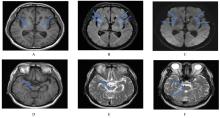| [1] |
Qinghua PING,Wenjing ZHU,Jianxin XIA.
Pustular psoriasis treated with secukinumab during pregency: A case report and literature review
[J]. Journal of Jilin University(Medicine Edition), 2023, 49(6): 1599-1603.
|
| [2] |
Rui ZHANG,Peng YU,Hao ZHANG,Yaru DONG,Ying PEI.
Personalized surgical treatment of severe cicatricial ectropion: A case report and literature review
[J]. Journal of Jilin University(Medicine Edition), 2023, 49(6): 1615-1619.
|
| [3] |
Qingshuai WANG,Bo CHEN,Hairui ZHANG,Xiongfeng TANG,Xue GAO,Yingzhi LI.
Arthroscopic treatment of subsynovial hemangioma of knee joint: A case report and literature review
[J]. Journal of Jilin University(Medicine Edition), 2023, 49(4): 1034-1039.
|
| [4] |
Yunke LUO,Jian ZHANG,Wenwen ZHANG,Zongsheng DUAN,Hushan WANG,Yiheng WANG.
Intracranial aneurysm rupture complicated with acute myocardial infarction: A case report and literature review
[J]. Journal of Jilin University(Medicine Edition), 2023, 49(3): 777-781.
|
| [5] |
Shengnan YANG,Xue WANG,Xuefeng WANG,Tianyu ZHAO,Ying PAN,Dayong DING.
Retroperitoneal giant lymphangioma: A case report and literature review
[J]. Journal of Jilin University(Medicine Edition), 2023, 49(2): 508-513.
|
| [6] |
Qian LI,Jingyi YUAN,Jiaqi ZHOU,Min ZHAO,Ke WANG.
Pulmonary imaging changes as first manifestation of angioimmunoblastic T-cell lymphoma: A case report and literature review
[J]. Journal of Jilin University(Medicine Edition), 2022, 48(3): 796-800.
|
| [7] |
Junjie HOU,Xuguang MI,Xiaonan LI,Xiaonan LI,Ying YANG,Xianzhuo JIANG,Ying ZHOU,Zhiqiang NI,Ningyi JIN,Yanqiu FANG.
Treatment of advanced rectal cancer with rectovaginal fistula through bevacizumab combined with FOLFIRI regimen: A case report and literature review
[J]. Journal of Jilin University(Medicine Edition), 2022, 48(3): 790-795.
|
| [8] |
Qian LI,Jiaqi ZHOU,Jingyi YUAN,Min ZHAO,Xin DI,Ke WANG.
Spindle cell carcinoma of lung: A case report and literature review
[J]. Journal of Jilin University(Medicine Edition), 2021, 47(6): 1557-1561.
|
| [9] |
Anming HU,Shuai GUO,Yumei ZHANG.
Analysis on clinical and rehabilitation characteristics of postoperative rehabilitation patients with intracranial tumor
[J]. Journal of Jilin University(Medicine Edition), 2021, 47(6): 1526-1530.
|
| [10] |
Dong CHEN,Na ZHOU,Xin ZHANG,Xiaoyu TAO,Wenyan TAN,Haicheng LIN,Shibin WANG,Liyuan PU,Wenhui GAO,Lina JIN,Yaqin YU.
Survey of status of severe mental disorders and comparison of clinical and epidemiological characteristics between community and hospital patients in Guangdong Province
[J]. Journal of Jilin University(Medicine Edition), 2021, 47(5): 1298-1305.
|
| [11] |
Meisi REN,Yu FAN,Qingrui XUE,Tianyu WANG,Guangxiang ZANG,Hongchen SUN.
Alveolar soft part sarcoma of right buccal mucosa: A case report and literature review
[J]. Journal of Jilin University(Medicine Edition), 2021, 47(5): 1281-1286.
|
| [12] |
LIU Jiaying, TIAN Chang, CONG Shan, ZHAO Min, WANG Ke.
Pulmonary sarcoidosis diagnosed by PET/CT as pulmonary lymphangitic carcinomatosis: A case report and literature review
[J]. Journal of Jilin University(Medicine Edition), 2019, 45(06): 1445-1448.
|
| [13] |
YANG Baoxia, LI Ping, WANG Cong, ZHANG Peng, ZHENG Baihong, XU Zhong.
Acute necrotizing encephalopathy of children with good prognosis: A case report and literature review
[J]. Journal of Jilin University(Medicine Edition), 2019, 45(06): 1449-1453.
|
| [14] |
TIAN Chang, LIU Jiaying, CONG Shan, ZHAO Min, WANG Ke.
Acute gout attack with persistent medium and high fever as first manifestation: A case report and literature review
[J]. Journal of Jilin University(Medicine Edition), 2019, 45(03): 714-717.
|
| [15] |
CAO Yingkun, LIU Liping, MA Xiaoshan, YE Guowei, JIANG Yining, BAI Shiqi, LI Yunqian.
Left temporal low-grade myofibroblastic sarcoma of infant: A case report and literature review
[J]. Journal of Jilin University(Medicine Edition), 2019, 45(03): 705-708.
|
 )
)





